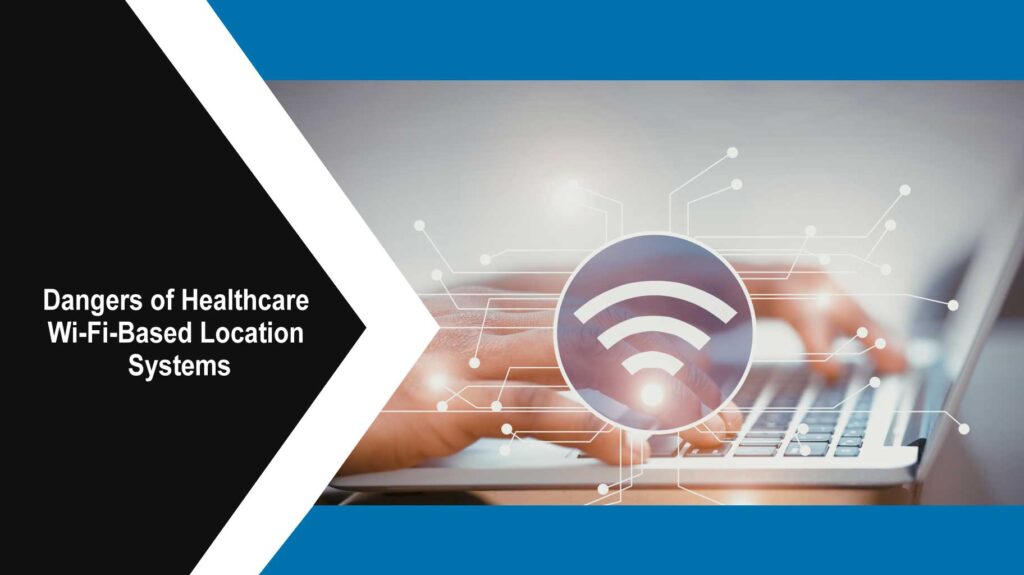Dangers of Healthcare Wi-Fi-Based Location Systems

(For those that require Wi-Fi credentials as part of their network requirements).
It’s common to use Wi-Fi to run medical equipment including infusion pumps, monitors, and real time locating systems (RTLS) in hospitals and Skilled Nursing Facilities (SNFs) but it puts the systems at much higher risk of a security breach through various well-documented attacks.
Common Theme and Risk
Across these cases, the attack vector was a locally present hardware device (Wi-Fi-enabled medical tool, smart gadget, or rogue device) that stored or had access to network credentials. Once attackers obtain those credentials or network access via the device, they can move laterally, access sensitive data, or deploy malware on the broader system. Notably, healthcare environments are full of IoT and medical devices (infusion pumps, monitors, HVAC sensors, etc.) that often have embedded credentials and are not always well-secured, making them attractive targets.
Another important consideration is BLE (Bluetooth Low Energy) plug-in systems may not initially appear to be WiFi-based, but they often rely on WiFi credentials to complete their setup and operation. This introduces a related threat vector: once WiFi credentials are entered—often via a BLE interface—they can be intercepted or misused if the BLE implementation lacks proper security. In essence, these systems become WiFi-enabled by proxy, and thus inherit many of the same risks as traditional WiFi-connected devices.
Industry surveys underscore these risks – 56% of healthcare organizations reported at least one cyberattack in the past two years involving an IoT or medical IoT device (Security challenges associated with healthcare IoT devices), meaning these hardware-based attack vectors are a current and growing concern.
Healthcare Sector Examples
- Infusion Pump Credential Exposure (2022): Security researchers discovered that Baxter’s Sigma Spectrum infusion pumps (with Wi-Fi battery units) stored hospital Wi-Fi credentials in their memory. An attacker with brief physical access could attach a battery module to a pump, power-cycle it, and cause the pump to write the Wi-Fi password to the module’s memory (Medical device vulnerability could let hackers steal Wi-Fi credentials | CSO Online). In testing, researchers bought used Baxter battery units on eBay and successfully retrieved what appeared to be valid hospital Wi-Fi SSIDs and WPA2 passwords from them (Four vulnerabilities discovered in popular infusion pumps, WiFi batteries | The Record from Recorded Future News). This kind of hardware vulnerability could let an intruder obtain network credentials and then use those credentials to access the hospital’s internal network.
- Decommissioned Medical Devices Leaking Credentials: A 2023 analysis by Rapid7 found that many retired or resold medical devices still contained sensitive network data. In a sample of 13 infusion pumps from secondary markets, researchers extracted clear-text Wi-Fi passwords, hospital network SSIDs, and even Active Directory login credentials that had not been wiped (Decommissioned Medical Infusion Pumps Expose Wi-Fi Configuration Data – SecurityWeek). This means if an outsider acquires discarded IoT medical equipment (e.g. an infusion pump or monitor) from a healthcare facility, they could harvest those stored credentials and later use them to log into the hospital’s network, leading to a broader compromise.
Financial Liability and Breach Costs in Healthcare
Data breaches in healthcare carry extremely high price tags. According to IBM’s annual analysis, the healthcare sector has the highest average data breach cost of any industry – about $10.93 million per incident, as of 2023, compared to an average of $4.45 million across all industries (Cost of a data breach: The healthcare industry).
The per-record cost of a breach is likewise steep – one report found an overall average of about $165 per compromised record in 2023 (IBM: Average Cost of a Healthcare Data Breach Increases to Almost $11 Million), but in healthcare the per-record cost tends to be much higher due to the sensitivity of protected health information. Strict regulations (HIPAA, HITECH, GDPR) and the extensive remediation efforts needed (forensics, notifications, credit monitoring, regulatory fines) drive these costs up (Cost of a data breach: The healthcare industry).
Breaches in healthcare also take longer to identify and contain (average 213 days to detect, vs ~194 days industry average (Cost of a data breach: The healthcare industry), which adds to the expense.
Publicly Reported Breach Costs and Case Studies
Real-world breach cases illustrate the financial liability hospitals face:
- Scripps Health (2021): A ransomware attack in May 2021 disrupted Scripps Health (a 5-hospital system in California) for nearly a month. Systems were down, patients were diverted, and operations were halted. The direct financial impact was estimated at $112.7 million in losses (Scripps Health Ransomware Attack Cost Increases to Almost $113 Million). Notably, about $91.6M of that was lost business revenue during the downtime, and $21M went to recovery costs (Scripps Health Ransomware Attack Cost Increases to Almost $113 Million). Insurance only covered a fraction of the loss. In addition, Scripps later faced class-action lawsuits and notification costs for 147,000 affected patients, which would further add to the liability (Scripps Health Ransomware Attack Cost Increases to Almost $113 Million).
- Universal Health Services (2020): UHS, one of the largest U.S. hospital chains, was hit by a Ryuk ransomware attack in late 2020 that knocked out systems across roughly 400 facilities. In its financial filings, UHS reported about $67 million in pre-tax losses due to the attack (Scripps Health Ransomware Attack Cost Increases to Almost $113 Million). These costs included remediation IT expenses and significant lost revenue from the multi-week disruption of patient care (elective procedures canceled, ER patients diverted, etc.). This figure gives a sense of how even a single cyber incident can impose tens of millions in direct losses on a healthcare provider.
- Regulatory Fines and Settlements: Beyond immediate damage, healthcare breaches can lead to government penalties and legal settlements. For example, Anthem Inc.’s massive 2015 breach (while older, affecting 79 million people) resulted in a $16 million HIPAA fine from HHS and a $115 million class-action settlement. More recently, smaller breaches have seen hospitals pay penalties in the millions. These fines, along with litigation costs, drive up the total “cost per breach” when calculating liability. (For instance, a mid-sized hospital that leaks a few thousand patient records might incur regulatory fines in the order of $1–3M, on top of internal recovery costs.)
- Industry Average vs. Actual Incidents: It’s important to note that while the average healthcare breach cost is around $10M, individual cases can vary widely. Many breaches at small clinics (say, the theft of a single device or a minor IT intrusion) might cost under $1M. On the other end, large-scale breaches or prolonged ransomware outages at major health systems can easily run into the hundreds of millions (consider the extreme case of the NHS England “WannaCry” incident in 2017, estimated at £92M (~$120M) in damage and response costs (WannaCry ransomware attack – Wikipedia). Thus, the financial liability ranges from significant to catastrophic, depending on the scale of compromised data and the extent of operational disruption. What remains consistent is that healthcare breaches are disproportionately costly – year after year, healthcare tops the charts for breach expenses (Cost of a data breach: The healthcare industry), reflecting both the high value of medical data on the black market and the heavy consequences of lost patient trust and care disruption.
The Best Way to Avoid Data Breach
It’s simple. Don’t rely on Wi-Fi for your security solutions. Our staff duress Help Alert® system uses LoRa gateways with beacons and BLE badges not like panic buttons that depend on Wi-Fi. Not only does our system not rely on Wi-Fi, but it is also so comprehensive it can easily cover a multi-story building and an entire healthcare campus. Our system covers inside and outside including in parking lots, outdoor facilities, and more with pinpoint location accuracy once the panic button is pressed. Avoid the inevitability of security breaches and costly liabilities from medical equipment that stores Wi-Fi credentials by switching to a closed system like our Help Alert® System.
Schedule a demo of Help Alert today!
Conclusion
In summary, the annualized risk exposure for a hospital from attacks via compromised local devices can be estimated by combining an increasing probability of occurrence (with IoT threats on the rise) and the heavy financial impact seen in recent breach cases. For an individual hospital, this might translate to an expected loss on the order of hundreds of thousands to a few million dollars per year when averaged out – a sobering figure that highlights why cybersecurity is now a key component of financial liability planning in healthcare. Each actual incident can be a budget-breaking event, so understanding these risk metrics helps hospitals prepare and allocate resources accordingly.
Sources: Recent cybersecurity reports and breach disclosures were used to inform these estimates. Industry studies (IBM/Ponemon) on data breach costs show healthcare breaches averaging $10M+ (Cost of a data breach: The healthcare industry), and surveys indicate a high prevalence of IoT-related security incidents in healthcare settings (Security challenges associated with healthcare IoT devices). Notable case studies from 2017–2022 further illustrate the mechanics and costs of attacks initiated via local hardware devices (from smart pumps (Medical device vulnerability could let hackers steal Wi-Fi credentials | CSO Online) to fish-tank sensors (Attackers exfiltrated a casino’s high-roller list through a connected fish tank), underlining the financial stakes for hospitals. Each citation above provides additional detail on these incidents and statistics.
